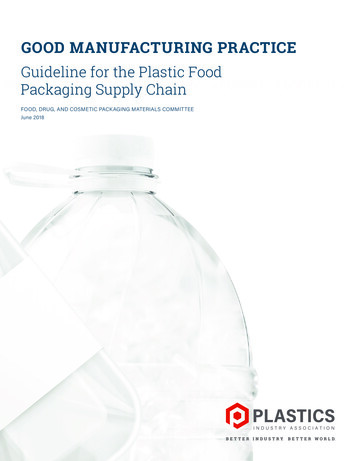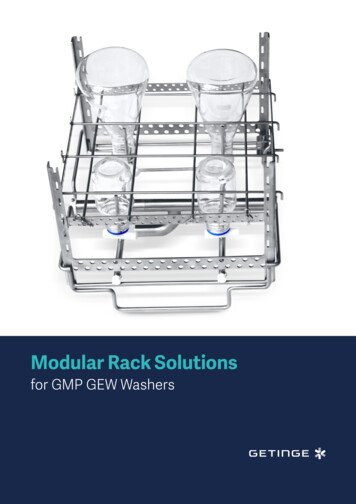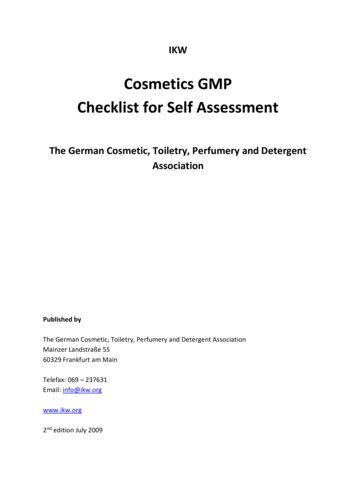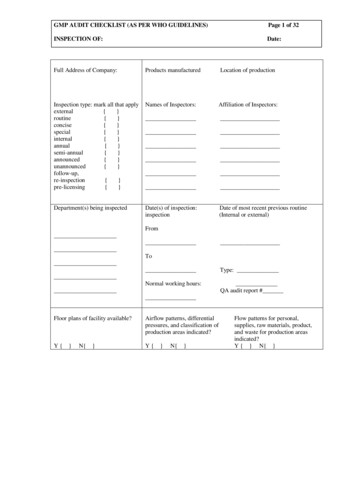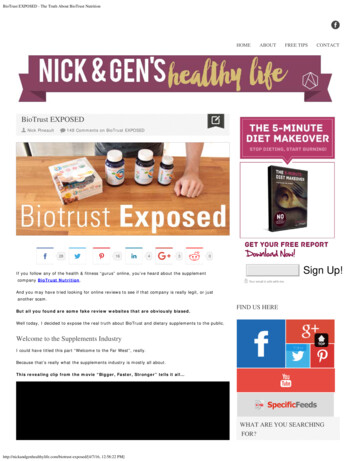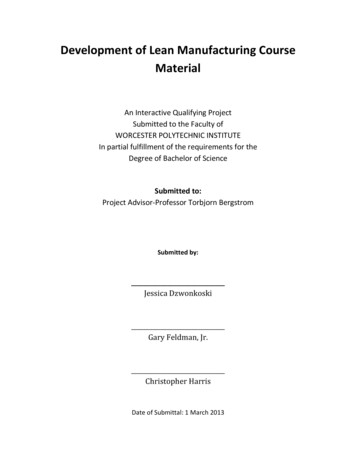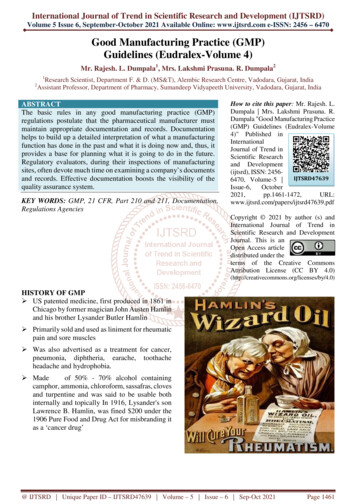
Transcription
International Journal of Trend in Scientific Research and Development (IJTSRD)Volume 5 Issue 6, September-October 2021 Available Online: www.ijtsrd.com e-ISSN: 2456 – 6470Good Manufacturing Practice (GMP)Guidelines (Eudralex-Volume 4)Mr. Rajesh. L. Dumpala1, Mrs. Lakshmi Prasuna. R. Dumpala212Research Scientist, Department F. & D. (MS&T), Alembic Research Centre, Vadodara, Gujarat, IndiaAssistant Professor, Department of Pharmacy, Sumandeep Vidyapeeth University, Vadodara, Gujarat, IndiaABSTRACTThe basic rules in any good manufacturing practice (GMP)regulations postulate that the pharmaceutical manufacturer mustmaintain appropriate documentation and records. Documentationhelps to build up a detailed interpretation of what a manufacturingfunction has done in the past and what it is doing now and, thus, itprovides a base for planning what it is going to do in the future.Regulatory evaluators, during their inspections of manufacturingsites, often devote much time on examining a company’s documentsand records. Effective documentation boosts the visibility of thequality assurance system.KEY WORDS: GMP, 21 CFR, Part 210 and 211, Documentation,Regulations AgenciesHow to cite this paper: Mr. Rajesh. L.Dumpala Mrs. Lakshmi Prasuna. R.Dumpala "Good Manufacturing Practice(GMP) Guidelines (Eudralex-Volume4)" Published inInternationalJournal of Trend inScientific Researchand Development(ijtsrd), ISSN: 2456IJTSRD476396470, Volume-5 m/papers/ijtsrd47639.pdfCopyright 2021 by author (s) andInternational Journal of Trend inScientific Research and DevelopmentJournal. This is anOpen Access articledistributed under theterms of the Creative CommonsAttribution License (CC BY STORY OF GMPUS patented medicine, first produced in 1861 inChicago by former magician John Austen Hamlinand his brother Lysander Butler HamlinPrimarily sold and used as liniment for rheumaticpain and sore musclesWas also advertised as a treatment for cancer,pneumonia, diphtheria, earache, toothacheheadache and hydrophobia.Madeof 50% - 70% alcohol containingcamphor, ammonia, chloroform, sassafras, clovesand turpentine and was said to be usable bothinternally and topically In 1916, Lysander's sonLawrence B. Hamlin, was fined 200 under the1906 Pure Food and Drug Act for misbranding itas a ‘cancer drug’@ IJTSRD Unique Paper ID – IJTSRD47639 Volume – 5 Issue – 6 Sep-Oct 2021Page 1461
International Journal of Trend in Scientific Research and Development @ www.ijtsrd.com eISSN: 2456-6470WHATHISTORYTEACHESUS PHARMACEUTICAL DISASTERSThalidomide Tragedy: Thousands of children bornwith birth defects due to adverse drug reactions ofmorning sickness pilltaken by mothersMedical devicesProcessed foodUsually see “cGMP” – where c current, toemphasize that the expectations are dynamic. It isdesigned to minimize the risks involved in anypharmaceutical production that cannot be eliminatedthrough testing the final product.These regulations, which have the force of law,require that manufacturers, processors, and packagersof drugs, medical devices, some food, and blood takeprotective steps to ensure that their products are safe,pure, and effective.Require a quality approach to manufacturing,enabling companies to minimize or eliminateinstances of contamination, mix-ups, and errors.Protects the consumer from purchasing a product,which is not effective or even dangerous. GMPregulations address issues including record keeping,personnel qualifications, sanitation, cleanliness,equipment verification, process validation, andcomplaint handling.Contamination: Sulfathiaziole tablets contaminatedwith phenobarbital- 300 people died/injured .In short GMP makes the difference between nearlyright and exactly right.WHY GMP?Final testing of the product cannot ensure theQuality efficiency and safety.Final testing may alwayscontamination, error, etc.notdetectConformance to the predetermined specification.To minimize contamination eg:- microbialcontamination.To eliminate error.To produce product of consistent quality.Government requirement.Ensure quality product.Reduce rejects, recalls.GOOD MANUFACTURING PRACTICES(GMP)DEFINITION:GMP is that part of Quality Assurance which ensuresthat products are consistently produced and controlledto the quality standard appropriate to their intendeduse and as required by the marketing authorization.Good Manufacturing Practices (GMPs) areregulations that describe the methods, equipment,facilities, and controls required for producing:Human and veterinary productsSatisfied customers.Company image and reputation.CODE OF FEDERAL REGULATIONS (CFR):It is the Portion of FDA.The collection of final regulations published inthe federal register (daily published records ofproposed rules, final rules, meeting notices, etc.Divided into 50 titles.Current regulations of GMP appear in part 210(title 21) of code of federal regulationspublished by USFDA.@ IJTSRD Unique Paper ID – IJTSRD47639 Volume – 5 Issue – 6 Sep-Oct 2021Page 1462
International Journal of Trend in Scientific Research and Development @ www.ijtsrd.com eISSN: 2456-6470REGULATIONS AGENCIESGUIDANCE DOCUMENTS21 CFR, PART 210 AND 211 CURRENT GOODMANUFACTURING PRACTICEANQUICKVIEWOFTHEFDAREGULATIONSTitle 21 – Food and Drugs210 CGMP in Manufacturing, Processing,Packaging or holding drugs – General211 CGMP of Finished PharmaceuticalsIntroductionCFR – Code of Federal Regulations(Administrative Law) – 50 titles@ IJTSRD Unique Paper ID – IJTSRD47639 Volume – 5 Issue – 6 Sep-Oct 2021Page 1463
International Journal of Trend in Scientific Research and Development @ www.ijtsrd.com eISSN: 2456-6470Part 210 GeneralStatus of the regulationsRegulations set forth are “minimum”requirements!!!!Covers manufacturing, facilities and controls for Manufacturing, processing, packaging orholding of a drug productFailure to comply will render the drug to beadulterated The person who is responsible for the failureto comply shall be subject to regulatoryaction.Subpart EControl of Components and DrugProduct Containers and ClosuresSubpart F Production and Process ControlsSubpart G Packaging and Labeling ControlSubpart H Holding and DistributionSubpart ILaboratory ControlsSubpart JRecords and ReportsSubpart K Returned and Salvaged Drug ProductsApplicability:- Applies to drug products for humanuseDefinitionsThose set forth in 210.3 are applicableDefinitionsBatch:- A specific quantity of drug/materialintended to have uniform character and qualityproduced under a single manufacturing orderform during the same cycle of manufacture.Subpart B Organization and Personnel211.22 Responsibilities of QCThe QC unit shall have adequate laboratory facilitiesThey shall have the responsibility s impacting the quality of the drugproductResponsibilities shall be in writing and shall befollowed.Component:- Any ingredient intended for useINCLUDING those that may not appear in suchdrug productDrug Product:- Finished dosage formFiber:- Any particulate with a length at least 3times to its widthActive ingredient:- Any component intended tofurnish pharmacological activityDrug:- Drug is defined by the Act as anycompound that has effect in the diagnosis, cure,mitigation, treatment or prevention of disease orto affect the structure or function of the body ofman or animalsIn-process material:- Any material fabricated,compounded, blended or derived for use in thedrug product.Manufacture, processing, packing or holdingincludes:- Packaging and labeling, testing andquality control of drug productsQuality Control:- Any person or unit designatedby the firm to be responsible for duties relating toQCRepresentative Sample:- Samples drawn onrational criteria intended to accurately portray thematerial being sampled21 CFR Part 211Subpart AGeneral ProvisionsSubpart BOrganization and PersonnelSubpart CBuildings and FacilitiesSubpart DEquipmentSubpart A General ProvisionsScopeMinimum requirementsApplies to drugs for human use211.25 Personnel QualificationsEveryone shall have the education, training andexperience to do their jobs.Everyone who supervises those people shall havethe education, training and experience to assignfunctions to provide assurance for drug quality.There shall be an adequate number of qualifiedpersonnel.211.28 Personnel ResponsibilitiesWear clean clothing and protective apparelPractice good sanitation and health habitsLimited access areasIf you are sick – do you belong in the area211.34 ConsultantsShall have sufficient education, training andexperience to advise on the subject matter.Records maintained stating the name, addressand qualifications of consultants.SUBPART C – BUILDINGS AND FACILITIES211.42 Design & ConstructionAny building shall be maintained to facilitatecleaning, maintenance and proper operationsAdequate spaceOperations performed in defined areasReceipt, storage, holding, etc.All operationsPenicillin operations in separate area211.44 LightingAdequate lighting provided@ IJTSRD Unique Paper ID – IJTSRD47639 Volume – 5 Issue – 6 Sep-Oct 2021Page 1464
International Journal of Trend in Scientific Research and Development @ www.ijtsrd.com eISSN: 2456-6470211.46 VentilationAdequate ventilationAdequate equipment for control of environment(micro, dust, air-pressure)Air filtration provided211.48 PlumbingPotable water supplied under continuous positivepressureSystem free of defectsPotable water meeting EPA requirements (40CFR, Part 141)Drains of adequate sizeBack-flow prevention211.50 Sewage and RefuseDispose of trash, sewage and other refuse in asafe and sanitary manner211.52 Washing and toilet facilitiesAdequate washing facilities shall be providedHot and cold potable waterSoap and detergentAir dryers or single-service towelsEasy access to working areas211.56 SanitizationFacilities shall be maintained in a clean andsanitary conditionFree of rodents, birds, insectsThere shall be written procedures on cleaningschedules, methods, equipment and materialsShall be written procedures for rodent ides,insecticides, fungicidesFacilities shall be maintained in a good state ofrepairSUBPART D – EQUIPMENT211.63 Equipment design, size and locationEquipment shall be of appropriate design,adequate size and suitably located to facilitateoperations, cleaning and maintenance211.65 Equipment constructionEquipment material of construction not bereactive with product.Lubricants/coolants shall not come into contactwith product to alter the quality of the productEquipment cleaning and maintenanceEquipment and utensils shall be cleaned,maintained and sanitized to prevent malfunctionsand contaminationWritten procedures shall be established forcleaning and maintenance of equipment, utensils.Records shall be kept of maintenance, cleaning,sanitizing and inspection.Automatic, Mechanical & Electronic EquipmentAutomatic, mechanical and electronic equipment,computers, etc. used in the manufacturing areashall be routinely calibrated, checked andinspected as per written procedure with retainedrecords of calibrations, inspections, etc.Computers systems documentation and validationdocumentation shall be maintained.Computer systems electronic records must becontrolled including records retention, backup,and security.211.72 Filters Shall not release fibers into drug productsIf fiber releasing filters are necessary Additional filtering using 0.22 micron maxporosity 0.45 if manufacturing conditions so dictateUse of asbestos-containing filter is allowed onlyafter proving to FDA safety or effectiveness is notcompromisedSUBPART E – CONTROL OF COMPONENTSAND DRUG PRODUCT CONTAINERS ANDCLOSURE211.80 General RequirementsWritten procedures shall be made and followedfor receipt, sampling, approval, rejection.Handle and store in a manner to preventcontaminationBagged or boxed items shall be stored off of thefloor and be adequately space for cleaning andinspectionEach Lot/container shall be identified with codefor each lot received and status (quarantined,approved, rejected).211.82 Receipt and StorageShall be examined visually for appropriatelabeling as to contents, container damage/sealsbroken, contamination, etc upon receipt.Materials shall be quarantined until tested andreleased.211.84 Testing and Approval/RejectionMaterials shall be withheld from use until testedand released for use by Quality Control.From each lot shall be sampled upon appropriatestatistical criteria.Samples collectionClean the container if necessaryCollect the samples in designated area to preventcontaminationSamples shall be identified with lot#, date, anddone by, etc.Containers must show samples were taken@ IJTSRD Unique Paper ID – IJTSRD47639 Volume – 5 Issue – 6 Sep-Oct 2021Page 1465
International Journal of Trend in Scientific Research and Development @ www.ijtsrd.com eISSN: 2456-6470Samples shall be tested for at least oneidentification test.COA of manufacturer shall be acceptableprovided by at least one specific identification testby establishing vendor evaluation.Any lot that does not meet the specifications shallbe rejected.Use of Approved componentsMaterials shall be used/issued in FIFO.Deviation of FIFO shall be permitted, iftemporary and appropriate.RetestingMaterials shall be retested after storing a longtime might be have adverse affect on quality dueto exposure to air, heat etc.211.89 Rejected materialsRejected materials shall be stored underdesignated area to prevent the use formanufacturing.211.94 Drug product containers and closuresProvide protection from external factors thatcould contaminate or deteriorate drugShall not be reactive, additive or absorptive as toadversely effect productClean and suitable for useSpecification and test methods shall be writtenand followed.SUBPART F – PRODUCTION & PROCESSCONTROLSWritten procedures; deviationsWritten procedures shall be established andfollowed for Production (BMR) and processcontrols (in-process, Intermediate spec.)Process control functions shall be recorded at thetime of performance.Any deviation from the established procedureshall be recorded and justified.Charge-in of componentsEach batch formulation should attempt to make100% of specified active ingredientComponents for manufacturing shall be weighed,measured, or subdivided as appropriate andshould be verified by second person.QC released/approvedContainers are identified & Weight/measurementis correct per batch recordWhen a component is transferred to a nonoriginal container, it shall indicate – Name, urement in new container, – Batchfor which component was issued including name,strength and lot number, Each component addedto the batch shall be verified by the second person211.103 Calculation of yieldActual yields and percentages of theoretical yieldshall be determined at the conclusion of eachstage of manufacturing, processing, packaging, orholding of the drug product.Such calculations shall either be performed byone person and independently verified by asecond person.211.105 Equipment identificationStorage containers, processing lines, and majorequipment used during the production shall beproperly identified.Major equipment shall be identified by number orcode that shall be recorded in the batchproduction record to show the specific equipmentused.211.110 Sampling and testing of in-processmaterialsIn-process specifications shall be consistent withfinal specificationsIn-process materials tested for quality, strength &purity & be accepted or rejected by QCRejected material shall be quarantined in order toprevent use in Manufacturing211.111 Time limitations on productionWhen appropriate, time limits for the completionof each phase of production shall be established toassure the quality of the product.Deviation from established time limits may beacceptable if such deviation does not compromisethe quality of the drug product. Such deviationshall be justified and documented.211.113 Control of microbiological contaminationWritten procedures shall be established andfollowed to prevent objectionable microorganismsin drug products of non-sterile.Written procedures shall be established andfollowedtopreventmicrobiologicalcontamination into sterile drug products, Suchprocedures shall include validation.211.111 Time limitations on productionWhen appropriate, time limits for the completionof each phase of production shall be established toassure the quality of the product.Deviation from established time limits may beacceptable if such deviation does not compromisethe quality of the drug product. Such deviationshall be justified and documented.211.113 Control of microbiological contaminationWritten procedures shall be established andfollowed to prevent objectionable microorganismsin drug products of non-sterile.@ IJTSRD Unique Paper ID – IJTSRD47639 Volume – 5 Issue – 6 Sep-Oct 2021Page 1466
International Journal of Trend in Scientific Research and Development @ www.ijtsrd.com eISSN: 2456-6470Written procedures shall be established andfollowedtopreventmicrobiologicalcontamination into sterile drug products, Suchprocedures shall include validation.211.111 Time limitations on productionWhen appropriate, time limits for the completionof each phase of production shall be established toassure the quality of the product.Deviation from established time limits may beacceptable if such deviation does not compromisethe quality of the drug product. Such deviationshall be justified and documented.211.113 Control of microbiological contaminationWritten procedures shall be established andfollowed to prevent objectionable microorganismsin drug products of non-sterile.Written procedures shall be established andfollowedtopreventmicrobiologicalcontamination into sterile drug products.Such procedures shall include validation.211.125 Labeling issuanceStrict control shall be exercised over labelingissued for useCompare issued materials to masterReconciliation of labels should be maintainAll excess labeling bearing lot or control numbersshall be destroyedWritten procedures shall be established andfollowed for the issuance of labelingReturned materials shall be stored separately toprevent mix-ups211.130 Packaging and labeling operationsWritten procedures shall be established andfollowed for Packaging and Labeling operations,procedure shall cover the followingPrevention of mix-ups & contaminationIdentification and handling of set aside filled butunlabeled product.Identification of the drug product with a lot orcontrolExamination for suitability and correctness beforepackaging operationsInspection of packaging & labeling facilities toensure the previous products are removed andcleaned211.134 Drug product inspectionPackaged and labeled product should be finalinspected to assure correct labelingA sampling of units shall be collected andinspected for correctlabelingResults of inspection shall be recorded in batchrecord211.137 Expiration datingExpiration date should be determined by stabilitytestingLabel shall be reflect the storage conditiondetermined by stability testingExpiration date shall be bear on label for theproducts to be reconstituted and un-reconstitutedExpiration dates must be reflect on labelingSUBPART H –HOLDING AND DISTRIBUTION211.142 Warehousing proceduresQuarantine of drug products before release by thequality control unitStorage of drug products under appropriateconditions which may not affect thequality/strength211.150 Distribution proceduresOldest products are distributed first.Deviation is permitted if it is temporary andappropriateDistribution records should be maintain tofacilitate recall if required/necessarySUBPART I –LABORATORY CONTROLS211.160 General requirementsWritten procedure shall be established andfollowed for specification, test procedures,sampling and scientifically sound.Any deviation from established shall be recorded,justifiedInstruments calibrations should be performed asper procedures and schedulesInstruments which are failed don not use.211.165 Testing and release for distributionEvery batch should meet the specification prior toreleaseSampling and testing plans should be described inwritten procedureValidated method should be employed for testingAny batch, not met the specification shall berejected211.166 Stability testingStability studies should be performed.Stability sample should be simulated to themarketWritten procedure should be available with thefollowing detailsSample details (Quantity, batch # etc.)Testing intervalStability conditionsStability specifications211.170 Reserve sampleRepresentative of each batch sample shall beretained.@ IJTSRD Unique Paper ID – IJTSRD47639 Volume – 5 Issue – 6 Sep-Oct 2021Page 1467
International Journal of Trend in Scientific Research and Development @ www.ijtsrd.com eISSN: 2456-6470Sample quantity consists of two completeanalysisSample should be simulated to the marketSample should be retained up to 1 year afterexpiration.Sample should be examined visually once in ayear for any deterioration and to recorded211.173 Laboratory animalsPenicillin controlled in separate facilityIf, exposed to penicillin, the product shall betested for the presence of penicillin. Such drugproduct shall not be marketed until they compliesas per FDA requirements.SUBPART J –RECORDS AND REPORTSRecords shall be retained for at least 1 year afterthe expiration dateAll records or copies of such records shall bereadily available for review/inspectionProduct quality review should be performed oncein a year211.182 Equipment cleaning and use log211.180 General RequirementsEquipment usage records should be maintain.211.184 Container, closure, and labeling recordsRecords shall be maintain, includingSupplier name and lot numberDate of receiptApproved/RejectedLabel shall be compared with master211.186 Master production and control recordsMaster production and control records shall bemaintainMade by one person and checked by another(prepared, dated, signed –full signature)Complete list of componentsAccurate statement of weights, reasonablevariationsTheoretical reconciliation211.188 Batch production and control recordsBatch production and control records shall bemaintain, includesOperation dates & Equipments usedList of materials and quantitiesIn-process resultsActual yield & Theoretical yieldDeviationsDone by & Checked by sign211.192 Production record reviewBatch records including packaging and labeling,shall be reviewed and approved prior to release.If any batch failed to meet the specifications shallbe investigated and recorded.The investigation shall extend to other batches that may have been associated with the specificfailure or discrepancyA written record of the investigation shall bemade and shall include the conclusions andfollow-up.211.194 Laboratory recordsLab records include complete data from all tests:Description of sample received & Statement of eachmethodComplete record of all data –graphs, chartsInitials of person doing test and datesInitials of person checking and datesCalibration data maintainedStability records maintained211.196 Distribution recordsDistribution records shall be maintained Who, where, what, quantity211.198 Compliant filesComplaint files shall be maintained Investigations performed Include name of product, lot number, name ofcomplainant, nature of complaint, replySUBPART K –RETURNED AND SALVAGEDDRUG PRODUCTS211.204 Returned drug productsReturned products identified and heldIf conditions of return or storage are in doubt,investigation is warrantedProcedures shall be in writing211.208 Drug product salvagingProduct subjected to improper storage conditionsdue to disaster or accident shall not be salvagedUnless,Tests can show everything is OKEvaluation of conditions indicates product wasnot exposed to such harsh conditionsEudralex-Volume 4 of "The rules ins guidance for the interpretation of theprinciples and guidelines of good manufacturingpractices for medicinal products for human andveterinary usePART I- BASIC REQUIREMENTS FORMEDICINAL PRODUCTSChapter1- Pharmaceutical Quality SystemChapter2- PersonnelChapter3- Premise and EquipmentChapter4-DocumentationChapter5- ProductionChapter6- Quality ControlChapter7- Outsourced activities@ IJTSRD Unique Paper ID – IJTSRD47639 Volume – 5 Issue – 6 Sep-Oct 2021Page 1468
International Journal of Trend in Scientific Research and Development @ www.ijtsrd.com eISSN: 2456-6470Chapter8-Complaints and Product RecallChapter9- Self InspectionPART III- GMP RELATED DOCUMENTSPART II-BASIC REQUIREMENTS FORACTIVE SUBSTANCES USED AS STARTINGMATERIALSQ9 Quality Risk ManagementSite Master FileQ10 Note for Guidance on Pharmaceutical QualitySystemORGANIZATION AND PERSONNELSanitation and Hygiene-Personnel HygieneHEALTHHealth Examination for personnel in manufacturing and laboratory areas shall be done at the time ofrecruitment.Any person shown at any time to have an apparent illness or open lesions that may adversely affect thequality of products should not be allowed to handle starting materials, packaging materials, in-processmaterials or drug products until the condition is no longer judged to be a risk.BUILDING & FACILITY@ IJTSRD Unique Paper ID – IJTSRD47639 Volume – 5 Issue – 6 Sep-Oct 2021Page 1469
International Journal of Trend in Scientific Research and Development @ www.ijtsrd.com eISSN: 2456-6470EQUIPMENTMATERIALSMATERIALS STORAGE@ IJTSRD Unique Paper ID – IJTSRD47639 Volume – 5 Issue – 6 Sep-Oct 2021Page 1470
International Journal of Trend in Scientific Research and Development @ www.ijtsrd.com eISSN: 2456-6470PACKAGING AND LABELLING CONTROLHOLDING AND DISTRIBUTIONCOMMON PROBLEMS IN GMP EXECUTION:1. Organization:Lack of commitmentLack of resources for execution2. Layout & Construction:No quarantine areaInsufficient environmental monitoringCracked floor3. Equipment:No calibrationNo performance check of balance before useRustyParts not kept improperly4. Laboratory Testing:Poor reference standard keepingPoor data recordingReagent with no label5. Documentation & Recording:No signature; no countercheckImproper correction madeNo written procedureIncomplete complaint recordNo up-to-date training recordNo document review6. Labelling:Status not defined clearlyPoor labelling controlRelease label not kept securelyInadequate reconciliation of batch labelDefective equipment with no label7. Validation:Insufficient validationInsufficient raw dataNo validation programme@ IJTSRD Unique Paper ID – IJTSRD47639 Volume – 5 Issue – 6 Sep-Oct 2021Page 1471
International Journal of Trend in Scientific Research and Development @ www.ijtsrd.com eISSN: 2456-6470References: 1. Goodmanufacturingpracticesforpharmaceutical. A plan for total quality controlby willig.2.The Gazette of India .Sch – M.3.The Theory and practice of industrial pharmacyby Lachman. Pg:- 8044.www.bioscreen.com.5.Myers, John. Fundamentals of Production thatInfluence Industrial Facility Designs. AppraisalJournal. April 7e/20.4.11.html7.Dumpala and Khodakiya, IJPSR, 2021; Vol.12(3): icles/PMC4991121/10. https://www.dcvmn.org11. Mr. Rajesh Dumpala Ms. Jaini Bhavsar Mr.Chirag Patil "Quality by Design: A Present toFuture Perspective" Published in InternationalJournal of Trend in Scientific Research andDevelopment (ijtsrd), ISSN: 2456-6470,Volume-4 Issue-5, August 2020, pp.878-885.12. Lund, W.: Good manufacturing practices. Thepharmaceutical codex: principle and practice ofpharmaceutics. London, Edition 12, ThePharmaceutical Press, 1994, 362-397.13. Nally J. and Kieffer R.G.: GMP compliance,productivity and quality, Interpharm,1998, 465466.14. Nally J.D.: Good manufacturing practices forpharmaceuticals, Informa healthcare USA, Inc.,ISBN 10:0-8593-3972-3 & ISBN13:, Edition 6,New York, 2007, 978-0-8493-3972- 1.@ IJTSRD Unique Paper ID – IJTSRD47639 Volume – 5 Issue – 6 Sep-Oct 2021Page 1472
21 CFR, PART 210 AND 211 CURRENT GOOD MANUFACTURING PRACTICE AN QUICKVIEW OF THE FDA REGULATIONS Introduction CFR - Code of Federal Regulations (Administrative Law) - 50 titles Title 21 - Food and Drugs 210 CGMP in Manufacturing, Processing, Packaging or holding drugs - General 211 CGMP of Finished Pharmaceuticals

